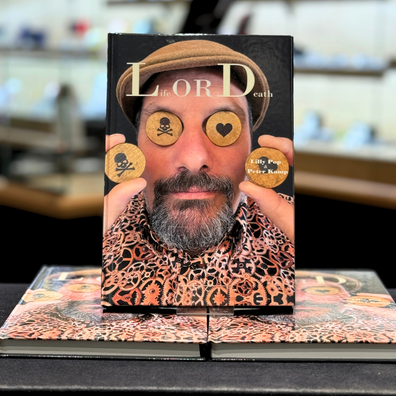SUBTILITÉS PSYCHOLOGIQUES - VOLUME 3
banachek
At the time of writing psychological subtleties 2, Banachek had a multitude of additional ideas (commercial routines, advice from friends, etc.) which he had decided not to include in the book to avoid creating a volume too much large for the format of the series. Although psychological subtleties 2 was elected 'Best book' From 2007, many ideas were preserved for the publication of a book accompanying the series.
This new book is The sum of a whole life of research and development, thanks to the multiple Banachek performances, as well as an eclectic group of colleagues and professionals from around the world who have understood the value and impact of ideas in the first book.
For many, the psychological subtlety series is considered to be The ultimate toolbox for the mentalist. It is very common to see a magician use an idea, a tower or a routine inspired by the philosophy of Banachek, by his performances or by his writings.
In this third volume, he continues to inspire readers by offering new creative ideas, as well as Complete routines Coming from his repertoire and that of his friends worldwide ... You will discover routines by Paul Alberstat, Sean Waters, Robert Domenech, Leonardo Silverio, Colin McLeod, Andrew Gerard, Marc Spelmann, Peter Nardi, Don Marco, Craig Leonard, Peter Arcane, Brad Henderson, Mark Roberts, Leo Boudreau, Jonathan Grant, Tony Binarelli, Docc Hilford, Kenton Knepper, Michael Murray, Richard Busch, Bryan Quinn, Francis J. Menotti, Ravi, Raj Madhok, Greg Arce, David Penn , and Joseph Atmore.
Psychological subtleties 3 contains Dozens of routines full of deceptions and psychological principles that you can add to your arsenal of magic and mentalism.
Features :
- 264 pages in French
- Format: 16 x 24 cm
- Quadri rigid cover
- Couture binding
- Translation by Vincent Hedan
- Benoit Drager
In the introduction of psychological subtleties 3, international living legend David Berglas evokes his relationship with Banachek and the respect he has for his talent!
Chapter UN - Subtile management of difficult spectators
Has your show already been disturbed by the ringtone of a phone? Has a spectator already refused to reveal what he thought of? Did a spectator already deliberately lie to what he thought of? This chapter deals with the management of this kind of moment and how to create the best conditions for your show so that these problems never happen again.
Chapter two - Subtile creation of the perfect situation
In this chapter, you will learn to use the first two minutes of your show to create an excellent first impression, as well as the subtleties on the ambiguity, and two incredible principles giving the impression that you know intimate details about perfect strangers . Why do psychological subtleties work for some artists and not for others? Banachek explains the importance of conviction. This chapter also reveals how to use a politically correct announcement to influence the thoughts of your volunteer, as well as a wonderful pseudo-explanation where you show spectators your method to make them think of a specific vegetable.
Chapter three - Subtile speech
Everything you wanted to know about the double verbal reality, and how to be right and twisted at the same time. Learn to formulate a sentence so that it is understood differently by your volunteer and your audience. In this chapter, you will also find "Perfect image!", An effect where the spectator is capable of describing an image (the color of a t-shirt, the color of the eyes and the name of a person, the time on A clock) without ever seeing it. "Ultimate Imagination" is a room visualization routine where the mentalist manages to guess the invisible play that the spectator thinks, and the hand in which he holds it.
Chapter Four - Subtle drawings
You will find one of Banachek's favorite tips, coming directly from his professional repertoire: the principle of the cat of Cheshire. In this purpose, you know how the spectator draws an image in his head, and you even guess that he has forgotten an important detail in the drawing. You will also learn a method of multiple drawing duplication, another duplication only based on psychology, and a routine where the mentalist predicts the image designed by the spectator.
Chapter five - Subtile letters
This chapter revisits the principle of Banachek where spectators mix the letters of a word in their heads, think of one of the letters and you guess it. The first two effects push this principle even further by allowing you to guess the letter, but also animals, places, people and other details that the spectator thinks. The chapter ends with a diabolical book test.
Chapter Six - Subtile cards
How to use different psychological principles to force playing cards.
Chapter Sept - Subtle dates
Four spectators think of a date in a calendar. The mentalist correctly identifies the date on which three spectators think and ends up with a surprising revelation on the date thought by the fourth spectator. This effect, "the Kalendrier de Kenton", was sold before for $ 20; Today it is included in this book. This chapter also contains two different methods to reveal the date of the day of the week in the year.
Chapter eight - Subtile psychokinesis
For metal torsion, it is important that the public sees the participant react physically to the phenomenon. You will learn to make the spectator feel the heat, the cold, or the torsion of a metal object in a bag. Many details are revealed to create these sensations from a physical and psychological point of view.
CHAPTER NEW - Subtil telephone
Playing Russian roulette, revealing a song designed by the spectator or detecting your lie, all on the other side of the wire.
Chapter Dix - Subtle numbers
This chapter revisits the principle of inversion of Banachek by giving it a meaning and by applying it to an ingenious book test. You will also rediscover the principle of "the gray elephant in Denmark" thanks to a new approach. This chapter also contains a prediction ending on an origami crow, produced by psychokinesis and then offered to the spectator.
Chapter Eleven - Subtle paradox
Predict the chosen part and if it is on the battery or face side; The M & M’s chosen and if it is the version with or without a peanut heart; the pace of taking a medication; The model of a car and the number of motor wheels. Also predict the spectator's PIN code and learn to create two separate realities at the same time.
Chapter twelve - Subtle perceptions
This chapter applies optical illusions to psychic effects. For example, the face on a bank note indicates whether the participant tells the truth or not. In another effect, two spectators read the thoughts of the mentalist by observing the scribble of a third spectator.
CHAPTER TREIZE - Subtil bet
Learn two different methods giving the impression that you have properly predicted the result of the lottery, as well as a clever idea to show that you had predicted the result of a sporting event.
Chapter Fourteen - Dunninger Subtle
This chapter reveals some of the daring subtleties used by Dunninger on stage during his famous television program.
Chapter Fifteen - Subtle News
Banachek reveals one of the best kept methods to predict the headlines.
Who is Banachek?
When psychological subtleties was published for the first time, Banachek was already an accomplished and recognized mentalist at the national level. After convincing scientists he had psychic powers during the "Alpha project", he went on television, in programs such as CNN Live, NBC TODAY and BBC; For PM Magazine, he was driving a car while having blindfolded. Articles in the New York Times, Omni Magazine, National Inquirer and Discover Magazine mention its exploits. He is also regularly invited to the radio, and refined his talents to the comedy clubs and during trade fairs across the United States. Banachek's ideas are considered to be revolutionary, but it is the subtleties behind its effects that make all its success. In this revised and increased book, he shares the tools he uses and shows you what is really at the heart of mentalism.

 English
English






















